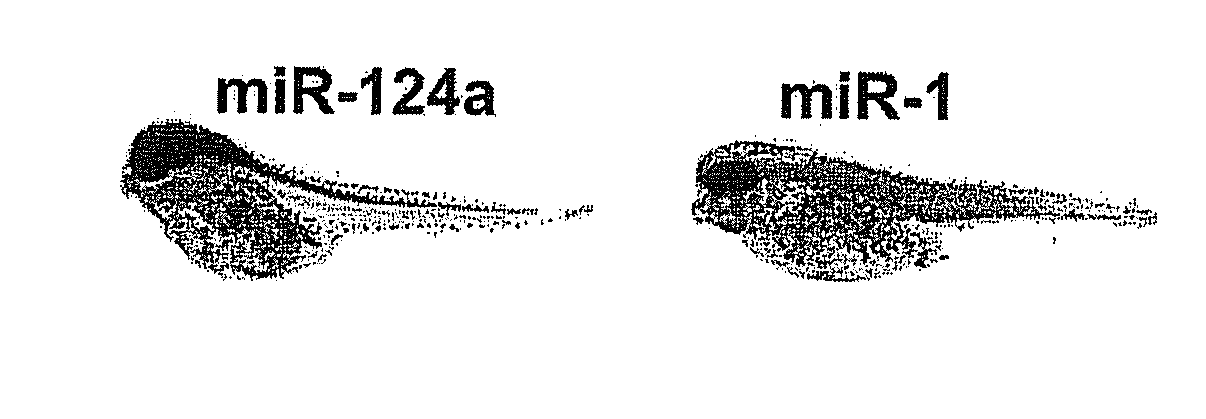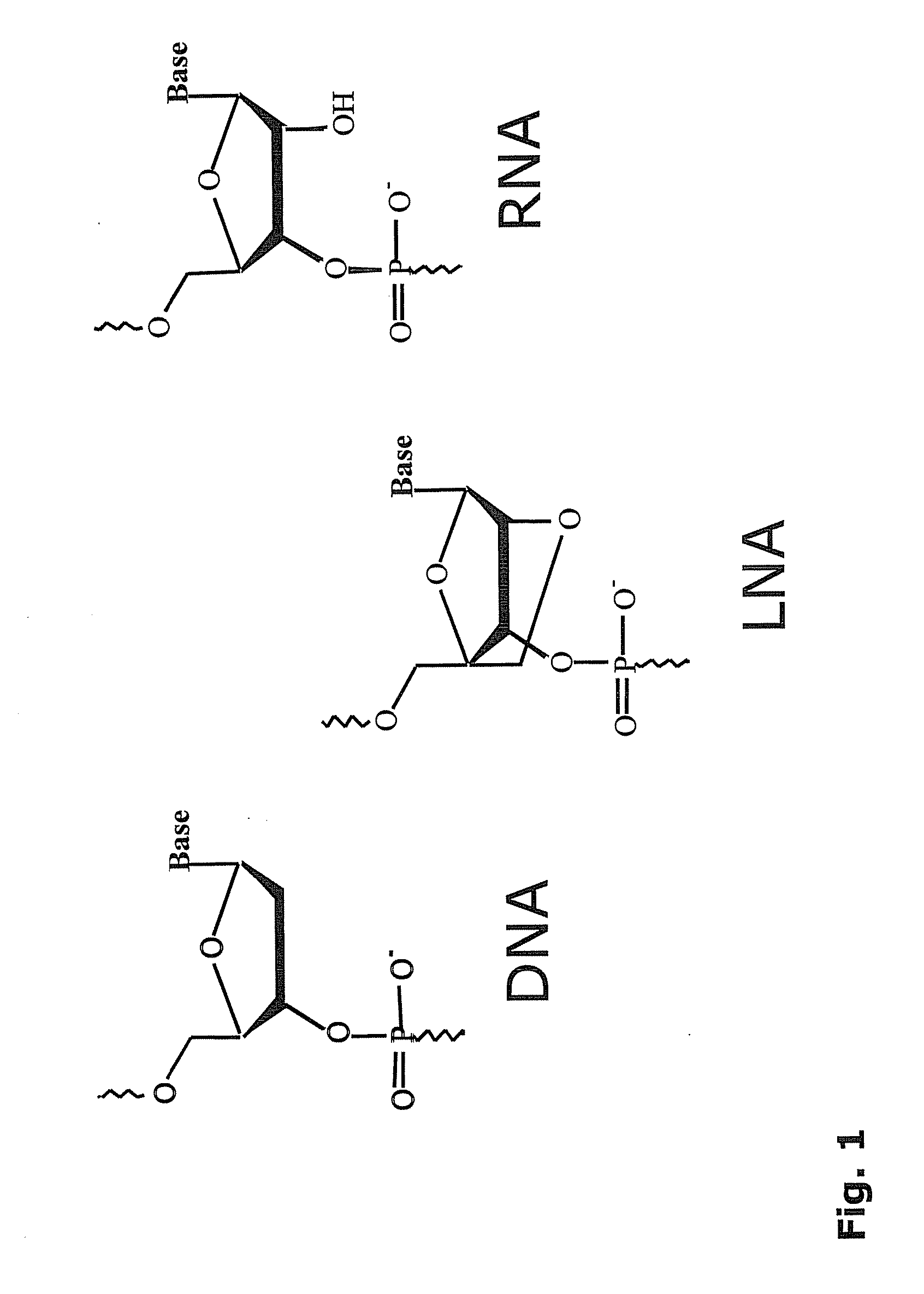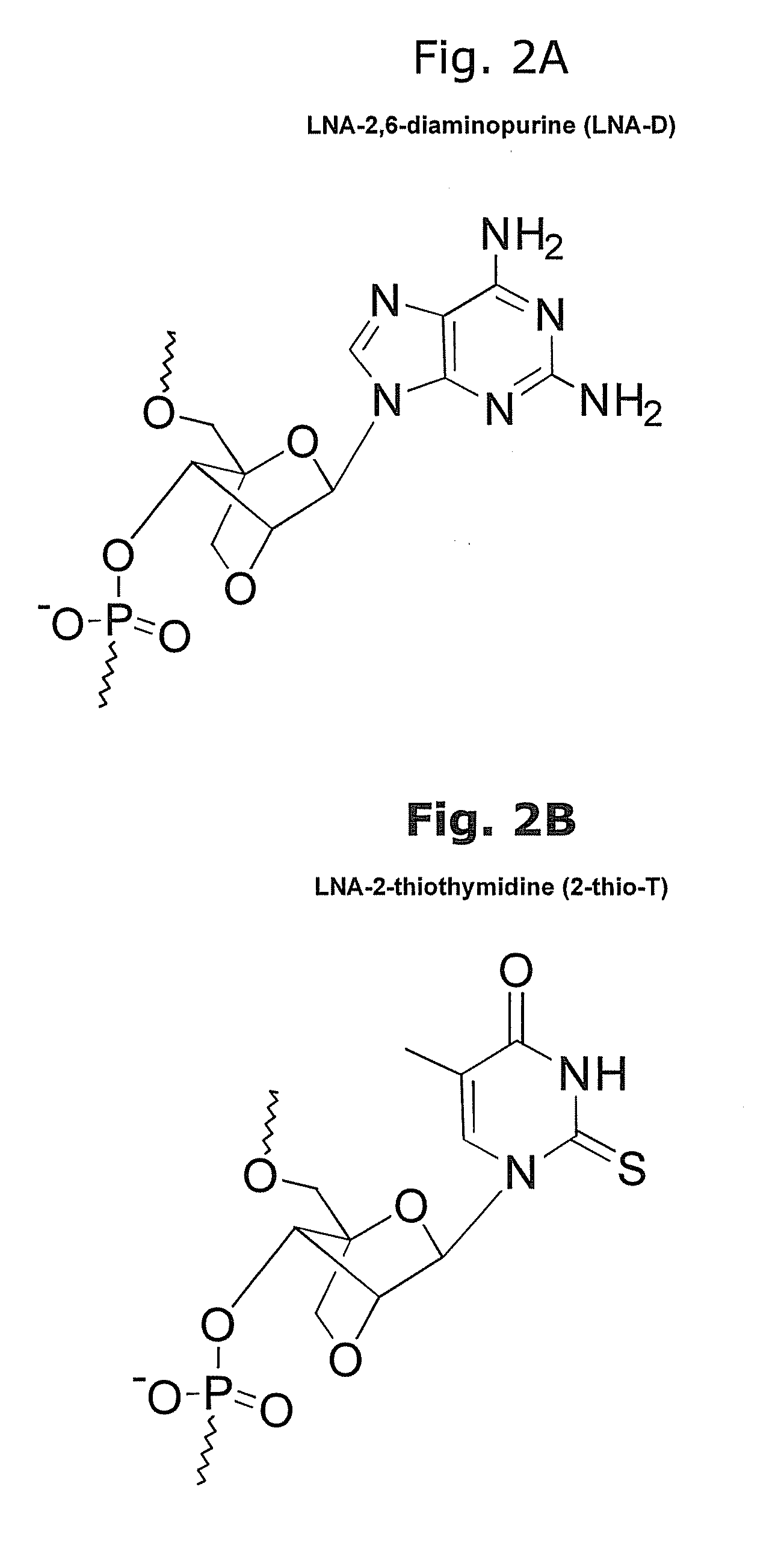Novel oligonucleotide compositions and probe sequences useful for detection and analysis of micrornas and their target mrnas
a technology of oligonucleotide compositions and probe sequences, applied in the field of detection and analysis of target nucleotide sequences, can solve the problems of low throughput, poor sensitivity, inability to achieve, etc., and achieve the effect of high usefulness
- Summary
- Abstract
- Description
- Claims
- Application Information
AI Technical Summary
Benefits of technology
Problems solved by technology
Method used
Image
Examples
example 1
Synthesis, Deprotection and Purification of LNA-Substituted Oligonucleotide Probes
[0174]The LNA-substituted probes of Example 2 to 11 were prepared on an automated DNA synthesizer (Expedite 8909 DNA synthesizer, PerSeptive Biosystems, 0.2 μmol scale) using the phosphoramidite approach (Beaucage and Caruthers, Tetrahedron Lett. 22: 1859-1862, 1981) with 2-cyanoethyl protected LNA and DNA phosphoramidites, (Sinha, et al., Tetrahedron Lett. 24: 5843-5846, 1983). CPG solid supports derivatised with a suitable quencher and 5′-fluorescein phosphoramidite (GLEN Research, Sterling, Va., USA). The synthesis cycle was modified for LNA phosphoramidites (250 s coupling time) compared to DNA phosphoramidites. 1H-tetrazole or 4,5-dicyanoimidazole (Proligo, Hamburg, Germany) was used as activator in the coupling step.
[0175]The probes were deprotected using 32% aqueous ammonia (1 h at room temperature, then 2 hours at 60° C.) and purified by HPLC (Shimadzu-SpectraChrom series; Xterra™ RP18 column, ...
example 2
List of LNA-Substituted Detection Probes for Detection of Fully Conserved Vertebrate microRNAs in All Vertebrates
[0176]LNA nucleotides are depicted by capital letters, DNA nucleotides by lowercase letters, mC denotes LNA methyl-cytosine. The detection probes can be used to detect and analyze conserved vertebrate miRNAs by RNA in situ hybridization, Northern blot analysis and by silencing using the probes as miRNA inhibitors. The LNA-modified probes can be conjugated with a variety of haptens or fluorochromes for miRNA in situ hybridization using standard methods. 5′-end labeling using T4 polynucleotide kinase and gamma-32P-ATP can be carried out by standard methods for Northern blot analysis. In addition, the LNA-modified probe sequences can be used as capture sequences for expression profiling by LNA oligonucleotide microarrays. Covalent attachment to the solid surfaces of the capture probes can be accomplished by incorporating a NH2—C6— or a NH2—C6-hexaethylene glycol monomer or d...
example 3
List of LNA-Substituted Detection Probes for Detection of Fully Conserved Vertebrate microRNAs in All Vertebrates
[0177]LNA nucleotides are depicted by capital letters, DNA nucleotides by lowercase letters, mC denotes LNA methyl-cytosine. The detection probes can be used to detect and analyze conserved vertebrate miRNAs by RNA in situ hybridization, Northern blot analysis and by silencing using the probes as miRNA inhibitors. The LNA-modified probes can be conjugated with a variety of haptens or fluorochromes for miRNA in situ hybridization using standard methods. 5′-end labeling using T4 polynucleotide kinase and gamma-32P-ATP can be carried out by standard methods for Northern blot analysis. In addition, the LNA-modified probe sequences can be used as capture sequences for expression profiling by LNA oligonucleotide microarrays. Covalent attachment to the solid surfaces of the capture probes can be accomplished by incorporating a NH2—C6— or a NH2—C6-hexaethylene glycol monomer or d...
PUM
| Property | Measurement | Unit |
|---|---|---|
| affinity | aaaaa | aaaaa |
| length | aaaaa | aaaaa |
Abstract
Description
Claims
Application Information
 Login to View More
Login to View More - R&D
- Intellectual Property
- Life Sciences
- Materials
- Tech Scout
- Unparalleled Data Quality
- Higher Quality Content
- 60% Fewer Hallucinations
Browse by: Latest US Patents, China's latest patents, Technical Efficacy Thesaurus, Application Domain, Technology Topic, Popular Technical Reports.
© 2025 PatSnap. All rights reserved.Legal|Privacy policy|Modern Slavery Act Transparency Statement|Sitemap|About US| Contact US: help@patsnap.com



